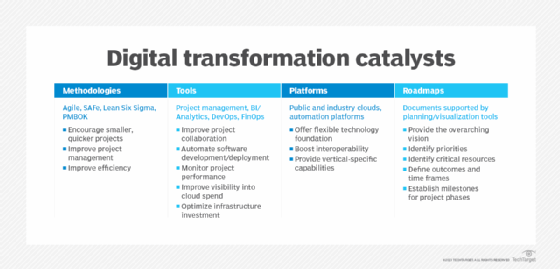The right digital transformation framework for your business
Digital transformation is tough. Find out how using a digital transformation framework can keep your company on the right track.
Decades into the widespread adoption of digital technologies, enterprises are still in the thick of digital transformation. The process of using digital technologies to fundamentally change how organizations operate, deliver value to their customers, and adapt to evolving business and market conditions is rife with challenges. Adopting a digital transformation framework that fits the culture and business objectives of your company will help.
What is a digital transformation framework?
A digital transformation framework is a blueprint that organizations use to guide and scale their efforts for continuously transforming their products, services and capabilities to meet evolving strategic goals and market conditions.
A digital transformation framework can also be described as a playbook that outlines how an organization should bring together strategy, technology, people, data and ecosystems as it plans, executes and communicates its transformation initiatives.
"It's a way to illuminate the work that needs to be done by your organization," explained Brian Jackson, research director in the CIO practice at Info-Tech Research Group, which has its own digital transformation framework.
This article is part of
What is digital transformation? Everything you need to know
A digital transformation framework is not the same as a digital transformation strategy, nor is it a roadmap. Rather it is a tool to organize the multiple elements that should be considered as part of a digital transformation (DX) program; it supports an enterprise DX strategy and can be used to devise a roadmap detailing how specific transformation work will be done.
 Sheldon Monteiro
Sheldon Monteiro
"The strategy is about figuring out how to play and to win; it's the part of digital business transformation that helps you figure out where you're heading. It doesn't help you figure out how to get there. That's the framework," explained Sheldon Monteiro, chief product officer with Publicis Sapient, a global digital transformation consulting company.
The importance of having a digital transformation framework
Digital transformation has become an essential element for organizational survival, according to enterprise executives. In a 2023 survey of business leaders from 1,000 organizations across multiple industries, 82% agreed that "companies must invest in digital transformation or be left behind."
Yet the same survey, published in the "2023 Insight Intelligent Technology Report: Are We in A New Era of Innovation?," an IDC InfoBrief commissioned by Insight Enterprises, found that not all leaders expect DX success: 61% said they expect to have their digital transformation efforts deliver an impactful return on investment by 2024 and only 23% expected to realize digital at scale by that time.
Meanwhile, spending on transformation initiatives continues to grow. Statista, a German market-data company, predicted that spending on DX technologies and services worldwide jumped from $1 trillion in 2018 to an anticipated $2.16 trillion in 2023 and will hit $3.4 trillion in 2026.
 Manuel Geitz
Manuel Geitz
Such statistics don't surprise DX experts, as studies have shown that organizations often fall short on their transformation objectives, requiring more investment.
"Most surveys point toward more than half of digital transformation efforts not delivering the intended results," said Manuel Geitz, principal analyst with Forrester Research. He noted that "the risk of failure is high since all dimensions of change need to be orchestrated in lockstep to get the most value out of modern technology."
There's a lot to coordinate, he and others said. Organizations must learn to move fast. They need to upskill their workers. They need to create new routines and processes. And they must build new partnerships and create new ecosystems to transform, with transformation being a means to deliver increasing value.
Frameworks foster unity, teamwork in digital transformation
This is where the value of using a framework comes in, experts said. A framework shows an organization's leaders how to pull together those elements and then orchestrate across them. A framework also focuses digital transformation leaders and their teams on using those coordinated elements to create new ways of working and deliver new products in support of strategic objectives.
 Brian Jackson
Brian Jackson
In other words, the framework helps the teams, even though they may be working on various elements, row together toward common goals.
"In the absence of a good framework to pursue digital transformation, you'll have a siloed organization where each department is more like a fiefdom with a narrow view of transformation without a unified vision of what the organization as a whole is pursuing," Jackson said.
Additionally, a framework establishes common, consistent terminology for speaking about transformation efforts and creates repeatable pathways to use for moving initiatives forward.
 Kamales Lardi
Kamales Lardi
"A framework helps you identify what you need, but its approach is closely linked to business objectives, so the transformation isn't done as a separate element or as part of IT but as part of the corporate strategy," said Kamales Lardi, author of The Human Side of Digital Business Transformation and CEO of Lardi & Partner Consulting. "The framework ties you to outputs."
It does this by creating a playbook for enterprise leaders to break down what they'll need across the various elements involved in transformation -- from talent, change management and technology requirements to process reengineering and risk mitigation -- thereby heightening the probability for digital transformation success.
"You need a framework to take good ideas, figure out how valuable they are, and how to then move them into live. And you need a process that does that in a sustainable and scalable way," Monteiro said. "It's all about developing a capability for continuous transformation, making it sustainable for the enterprise, and helping you achieve results consistently."

What makes an effective digital transformation framework?
Like all frameworks in business, a DX framework breaks down all the areas that enterprise leaders need to address, providing checklists and processes to ensure that they know how to account for what they have, articulate what they'll need, identify risks, determine desired outcomes and decide how to deliver them.
"In addition to covering the interdependent dimensions of change, an effective digital transformation framework enables an organization to find the right balance between value delivery, risk management and investment appetite to drive the intended results," Geitz said.
Many leading frameworks ask the organization to consider its current and desired states in the following six core areas:
- Culture.
- Customers.
- Employees.
- Organization.
- Strategy.
- Technology.
Not all frameworks, however, use the same terms or group of elements to describe what executives should be addressing for their DX efforts.
Variations on the six core areas listed above include the following: data and analytics, process and innovation, product and service digitization, operational efficiency, customer experience and engagement, business model innovation and new revenue generation
Meanwhile, Publicis Sapient zeroes in on three main areas, explained Monteiro.
- The first area focuses on value identification. "It's a way to look at what your customer or market wants, what capabilities you have and how do you identify what value you can create, because when you're doing digital transformation, everything has to be centered on the value you're trying to create," he said.
- Next is shaping and incubation, which Monteiro said looks at how the organization can "generate propositions that matter to the customers, how to put together digital products and services, then test [them] and learn as quickly and economically as possible whether they'll deliver." He said this element is called shaping, because the activities in this category will shape the organization's transformation activities.
- The third area is build and scale.
Monteiro pointed out that like all frameworks, the one from his company is meant to create a way for an organization to think about and execute activities in a repeatable fashion to increase the likelihood that it addresses all areas necessary to succeed time after time.
"That is key for how all successful digital transformations work: if you can do this in a continuous loop," Monteiro added.
Choosing the right framework for your business
A multitude of digital transformation frameworks exists. According to DX experts and advisers, some frameworks are more complete than others, while many are of equal value but might not be of equal use at all organizations, depending on enterprise digital culture, maturity, industry and the like.
 James Brouhard
James Brouhard
"You have to match the methodology you're going to use to how your organization operates or create or adapt a methodology that actually fits your culture," said James Brouhard, director of consulting and professional services at FNTS, an IT services provider.
He added: "Using a methodology that doesn't fit your culture doesn't bode well for success."
To illustrate this point, Brouhard pointed to the clients he serves in financial services, where the culture tends to be hierarchical and very structured. He said opting for a framework that's dynamic and fluid for such companies would require significant change management simply to work with the framework -- so much so it would delay the ability to effectively dig into the transformation initiatives themselves.
Organizations should also consider their DX strategy when selecting which framework to use, other DX advisers said.
"Think about strategy first: What is the purpose of your transformation? How do you intend to create and capture value with the new technology? Then assess the level of risk you want to accept during execution. This will define whether your transformation journey will resemble a marathon or a sprint," Geitz explained.
Furthermore, DX advisers said organizations should select a framework that speaks to business transformation, and not ones limited to transforming certain capabilities or functions. For example, the Scaled Agile Framework, with its guidelines for implementing agile practices at an enterprise scale, can help transform how IT delivers software products, but it does not provide the moves needed for shepherding the entire organization toward new ways of working or serving customers.
"You have to make sure the framework can land across your entire business," Monteiro said.
Despite such advice, experts said many organizations continue to forgo the use of any framework at all -- a factor that analysts said contributes to the high rates of failure for DX initiatives. (Studies have found the failure rate to be upwards of 70%.)
"Most are not following a playbook, and they don't have the skill set to develop [their own] framework," Geitz said.
Popular digital transformation frameworks in the enterprise
As noted earlier, there are a multitude of digital transformation frameworks, with many coming from management consulting and research firms. One caveat: Some frameworks that are marketed to support DX aren't truly DX frameworks but are instead playbooks that support narrower transformation efforts, such as bringing agile development to the enterprise.
Even so, experts said plenty of framework options remain.
Well-known enterprise-wide DX frameworks include Accenture's Total Enterprise Reinvention, EY's Transformation Realized, IBM's Garage and McKinsey's Rewired.
Other consulting and tech services firms offering their own DX frameworks and playbooks include Bain, Boston Consulting Group, Capgemini, Cognizant, Globant and Thoughtworks.






